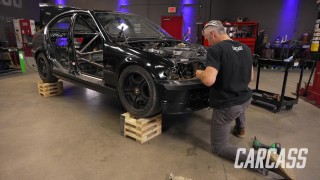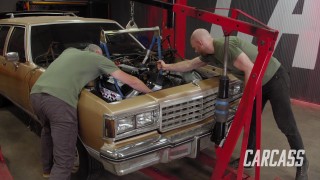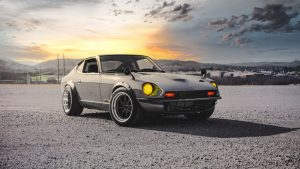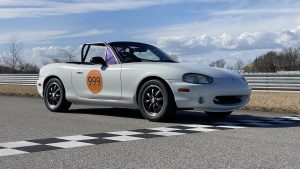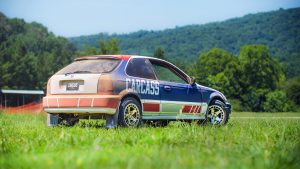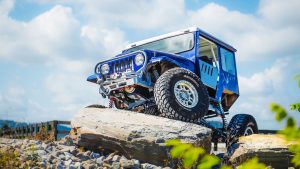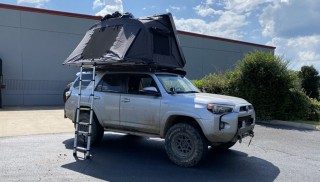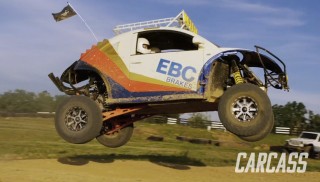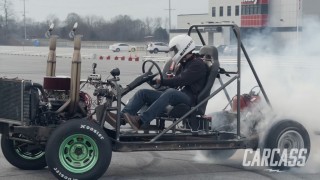Carcass Featured Projects
Carcass Builds
Want more content like this?
Join the PowerNation Email NewsletterEpisode Transcript
(Jimmy)>> You're watching Powernation!
(Jeremy)>> Today on Carcass we're rolling our '72 Camaro into the shop and we're gonna show you guys how we got this thing ready for SEMA.
(Jimmy)>> And we're gonna mount some more carbon fiber components and show you how to measure for coilovers and shocks. So stay tuned! [ Music ] [ engine revving ] [ Music ]
(Jeremy)>> Hey everybody, welcome to a brand new season of Carcass. Now Jimmy and I are excited to be working on a lot of different projects this year, but first and foremost is our 1972 Road Course Camaro. Now if you guys are just checking in on us for the first time or you need a little bit of a recap let us show you how we turn this rough around the edges Camaro into the race car you see before you. We started with a well used stock-ish Camaro RS that had some really good bones. We got to work stripping it down to just a shell so we could see what we had to work with. After finding a couple issues we dug into the body and added a set of mini tubs so we could fit up some wider tires, along with a fuel cell in the trunk. Then we laid out the groundwork for a race inspired roll cage to stiffen up the car and to keep us safe.
(Jimmy)>> The next thing to do is add some upgraded suspension in the rear along with a nine inch axle to handle the horsepower. Up front we cleaned up the sub-frame, did some mods, and replaced the suspension with some tubular upper and lower control arms.
(Jeremy)>> The engine and transmission install came next, which included moving it back about a foot and adding a front motor plate. To get it to fit in the Camaro we grabbed some cutoff wheels and trimmed the firewall to fit. Then we added a rear firewall to block off the fuel cell from the passenger compartment.
(Jimmy)>> The last thing we did was lay out a set of custom quarter panels and fender flares to fit our wheel and tire setup. That included some work with some expanding foam, body filler, fiberglass, and most importantly some carbon fiber.
(Jeremy)>> Then it was time to tackle the top. We stripped away all the old glue leftover from the vinyl. Next we removed the lead that was used on the factory body seams. With the roof all prepped we were ready to install it with the help of a couple friends. To make it go all smoothly we added a couple of tabs in the A-pillars to line everything back up.
(Jimmy)>> With our carbon fibered cured it was time to get them onto the car. We started by removing the old metal quarter panel, making sure to leave enough room for us to attach the new carbon skin. Once that was in place we attached the new carbon fiber trunk lid and secured it into place with some race inspired latches. Now that the top was back on we fabricated some gussets. Then welded them to the roll cage and the A-pillar of our Camaro, giving us some added chassis stiffening for better response out on the track. Now this past November Jeremy and I had the really cool opportunity to take our car to the SEMA show in Las Vegas with our partner EBC Brakes. So to get the car ready to go there a lot of things we did that you guys haven't seen in any of the episodes, and we wanted to share with you guys some of the challenges that we faced in doing some of these things. One of the biggest ones was getting the front sub-frame ready to drop in this engine. As you guys can see, the engine is sitting about eight back from the stock location, and as we tried to test fit it with this giant dry sump oil pump hanging off the side we ran into issues with the front crossmember. So as we started test fitting and chipping away at the front crossmember we just decided to it's gonna be easier to cut the entire thing out and build our own. So what was really cool about that process is we put the entire sub-frame up on a jig table, we located the lower control arm mounts, and then we just filled everything in between and made sure we had gussets in the right places to make sure thing was really strong. Moving back a little ways you guys can see there's a lot of tubing structure in the engine bay. That's because we wanted to tie in the roll cage to the front sub-frame. This makes the chassis and body extremely rigid and allows the suspension more efficiently and do its job properly. So we have four points of contact on the roll cage, and they come out to these two hoops on either side of the engine. Now Jeremy fabricated the firewall with some nice bead roll detail. We also make these plates to cover the holes that allow the tubes to come through as well. Now moving along onto the interior Jeremy also fabricated the entire transmission tunnel and the rest of the firewall. It was really cool to see this happen because I'm not really too familiar with sheet metal work. So I was just trying to watch and observe as much as I could, and I really think he knocked it out of the park with this one. We've also been working on the driver ergonomics, mounting the seat, getting the pedals in place with a heel plate to make it a little more comfortable. There's still some work to do there but it's well on its way. There still are a few things that we're gonna show you guys some point in the future, but that brings us to today, and we have a lot more work to do.
(Jeremy)>> And now that you're all caught up the next step is actually out here in the front of the car. The idea is to hang the core support up here on the frame rails, and then we're gonna be hanging a fender because what we want to see is how the wheel sits inside of the fender arch because ultimately the goal here is to setup the suspension so we can get an accurate measurement on our coilover, and then we'll go from there, send those measurements off, and have one made up. We're gonna go grab a bunch of parts, get all those in here, and start setting everything up. Coming up, we hammer and heat our damaged brackets, showing you how to manipulate metal to retain its old shape.
(Jeremy)>> Alright guys, to get started up front we need to start with the main structure of the front of the car and that is the core support. Now the reason why it's called a core support is the fact that it does support most of the front stuff like your radiator, and in this case your air conditioning, and it also supports both of the front fenders. Now our Camaro has been in some type of an accident or something up front. We have a lot of bent brackets up here. There's big damage to the a/c condenser, which isn't a big deal to us because we're gonna end up throwing that in the trash, and there's damage over here to a couple of brackets, but that's nothing that we can't handle. We're gonna straighten all of this out. This being a race car there really is no point in going out and buying a new core support because all it's gonna do at this point is help locate our two front fenders. Then we're gonna use the rest of this to help build out the front of the car so it looks like a Camaro again. I do have to get some of these brackets out of the way just so I can start straightening them out and get them on the table. Use the flat surface here to really pounds these back straight. Then from there we're gonna hang some of the front on, maybe the nose cone, make sure everything is straight, and then we'll take this over to the car, get it on the car, and we'll start hanging the front fenders. [ drill humming ]
(Jeremy)>> Okay, it's a good idea to mark all of your brackets, especially something like this where it could be flipped over and go on the other side as well. So you just grab a Sharpie. What I do is I'll put an "L" on it for Left, put an arrow that faces down, and that way I know it goes on this side and it goes down. [ drill humming ] [ metal clanging ] [ drill humming ] [ Music ]
(Jeremy)>> Scrap pile. So now that we have the brackets off if we take a really close look at this center bracket, or piece here, I'm going to assume that this should be completely straight. There's damage you can see. So I'm just gonna use the table to try to straighten this out the best I can. As far as the side brackets go, if you look at the left bracket it looks like there's no damage to it. So we're gonna assume this one's straight, but when you put the right side, or the passenger side, bracket up to the same spot you can see that it's off and there's some good bends to it. So if we try to match the two sides here I can see that the ears are off the table. So I'm gonna assume that this one's bent. So we're gonna have to do some work here too. This one's a little more heavy duty. So we may have to use the vice, some bigger hammers, or even some heat to straighten this one out. As far as the center one goes it's just some thin sheet metal. So we're gonna pound on the table here. Got the hammers and dollies. Gonna put my safety glasses and some hearing protection on. I'm just gonna try to nail this thing straight. Then we'll put it on the core support again and we'll try to test fit the nose cone. [ Music ] [ metal clanging ]
(Jeremy)>> We'll use that to kinda block this side up so we don't bend that tab. Then we'll just hammer here and try to straighten this out first. [ Music ] [ hammer tapping metal ]
(Jeremy)>> Switch! [ hammer tapping metal ]
(Jeremy)>> Quite a bit straighter in there. Try to straighten this out. [ hammer tapping metal ]
(Jeremy)>> Here's a little trick too. If you don't have a hammer that fits in a certain spot to work something straight your dolly works just as good as a hammer. You can pick that up and slam it down. Find whatever works here and use that to straighten stuff out. Try to straighten this out here, which that might just be a push. Maybe not! That we might just use the vice for. Put the vice in here and just use the pressure. So I'll try to straighten that out on the vice. [ Music ] So that's straight. We're gonna use that to our advantage now that it's in here. I think I've got to straighten it out here. So we're just gonna pull on this side to bring this up top, which I'll probably have to use quite a bit of force. I don't know if you guys can see that. As I pull here you can watch this side straighten itself out. The metal is moving and it knows where it has to go. So as I pull this side over watch that side. It actually moves back into position. So it's actually straightening itself out more and more. Then you can see how straight this is now. So sometimes, as Bob Ross would say, happy accidents. Little bit that's left. We can move that into shape once it's back on the core support. We'll call that a win. Let's see what we can do here. [ Music ] This bracket is made of a thicker material. So we'll use a little bit of heat to make the tab end a little bit easier. When bending metal like this you'll want to use steady pressure and be careful where you grab the part because this heat can travel a long way throughout the material. [ torch hissing ] [ Music ]
(Jeremy)>> That's warm! [ Music ] That's about all it wants to bend. So we're gonna leave it right there. We use the power of pressure to finish straightening our core support brackets to install our new nose cone.
(Jeremy)>> So the brackets are somewhat straight. The core support's somewhat straight. So we're gonna go ahead and mount this up on the table. We'll get all the brackets on this thing and we'll test fit the nose cone and see how close we are. [ Music ] [ metal clanging ] [ Music ]
(Jeremy)>> Now these brackets we marked left and right, and up and down, so I know where they're going. So now that we have the brackets on the next step is to install the nose cone and make sure everything's straight. Now our old nose cone was damaged pretty bad. So we got a brand new one from Classic Industries. This is made from a high impact urethane, and probably the biggest point for us is the fact that it's straight cause our old one was in pretty rough shape. Now when we hold it up here we can already tell that it doesn't fit in between the brackets, and I'm pretty sure we know why and there's a bunch of damage on this side, but we're gonna try to prove that point right now. So Jimmy brought in a straight edge. What we're gonna do is assume that this bolt hole in the top of the core support is centered, and we're gonna use a straight edge to make sure that it does show that the left side's in better shape than the right side. So if I hold the nose cone up to the left side bracket and Jimmy holds that straight we can basically tell that this leading edge matches the peak of the nose cone. So we know that the left side is in good shape. That pretty much proves the point because this side is what we did most of the work on. Now I can't move anything on this side. The way that it's mounted to the table it's just gonna move around too much. So from here what we're gonna do is take the core support off and we're actually gonna go put it on the Camaro. We're gonna use the mounts for the core support on the frame to make this thing rigid. Then we'll do a little bit of pushing and pulling, basically over here on the passenger side, or the right side, and get this all to fit in there. That's pretty much the next step. We'll get this thing unscrewed. Jimmy and I will take it over to the Camaro, and we'll get it all set up. [ Music ] So we have the core support sitting on the chassis rails. We've got the body mount bolts in kinda holding it loosely into position, and I've got this hydraulic ram in here. It's called a Port-a-Power or a port-a-brace. What this does is it's just gonna use a little bit of hydraulic pressure, when I pump the handle and use the ram here and shift this bracket out. Now if you guys don't have something like this you can easily do it with a pipe or a bar. Find a way to get in here, and just pry and pull it over, but we're gonna use hydraulic pressure. We're gonna go nice and easy on this, and then we'll do a test fit with the nose cone to see how much movement we've gotten out of the bracket. Then we'll see if it works from there. Just do a couple of pumps here and check the nose cone once. Make sure it fits inside. Once I've got it fitting I will actually go past the point I need to let it all relax back cause it's gonna kinda spring back if you will. So we have to go quite a bit actually. Even by doing it this way I'm actually using the bracket and maybe changing some of the damage that could be in the core support itself. Pass a little bit and I've got to do some tweaking here I can tell already. See here once I take it off. That really relaxed. May have to do this a couple of times but we'll get it. Top's good. Push on the bottom a little more. [ Music ] [ press handle clicking ]
(Jeremy)>> Try to shift the bottom. Top's moving too, but use a big pair of channel locks. We're gonna shift the top back. Leave the pressure on it to help move these brackets around a little bit since it's kinda twisted. Now I've just got to get it to stay there. So I'm gonna go way past. Let it relax for a second and see where we are. [ Music ] Oh yeah, right there. That's almost perfect! Grab some bolts and put the nose cone on. Nose cone's on, it fits. Now we'll just move on and get a fender on this thing. [ Music ] So we got the fender on the car. Core support's in it. We just had to tweak the core support a little bit. The other thing that we are running into is the actual steel structure part of the fender is sitting on top of the tire. So it's not allowing me to push the fender in completely. We knew that was gonna happen and we do have a solution for it.
(Jimmy)>> Coming up, we fix our fender problem and measure for a set of coilovers.
(Jimmy)>> Jeremy has the core support mounted on our Camaro. And like he explained, the fender doesn't really fit because the tires are so wide that they hit the underside structure. So what I'm gonna do now is go ahead and cut some of this fender structure out and get our carbon flares put in place. Just to give you guys a little bit of a recap the reason why we did the flares in the first place is just so we could have a wider track width and still be able to tuck the wheels and tires underneath and make it look really nice. Now one big benefit of using some of this fender structure to mount our flares is that we retain these stock mounting points of the fender. So it goes right back on the car. We'll get some rigidity once we rivet everything together, and also we retain the headlight bucket geometry, which allows everything just to go back in its original place. So of course there's gonna be some weight savings by cutting this out, putting the carbon on. It's probably gonna be negligible, but I think this is a nice compromise of making it a little bit easier to get our flares onto the car. [ drill humming ]
(Jimmy)>> To cut the fender structure out I'm gonna start with a hole saw. This will give us a nice, rounded edge to prevent any stress risers, and then I'll cut the rest out with a cutoff wheel. [ drill humming ] [ Music ] [ saw buzzing ] [ Music ] [ saw buzzing ] [ Music ] [ saw buzzing ] [ Music ]
(Jimmy)>> So I've got the fender and our carbon flare roughly trimmed. So at this point what I'm gonna do is go ahead and drill some holes. We'll get this thing Clico'ed on there and then we'll go ahead and get it back on the car, test fit everything, and then we can measure for our coilovers. [ drill humming ] [ Music ]
[ drill humming ] [ Music ]
(Jimmy)>> Got these two Clico'ed together. We'll see how everything looks. [ Music ]
[ Music ] I've got the fender on the car and fitting the way that I want it to, and I can see already that it's just a little bit too low. So we're gonna go ahead and jack the car up and get our setup rod maybe a half inch to three-quarter of an inch taller, and then we can take a measurement and send them off. [ Music ] So I've adjusted the setup rod and we'll set the car back down on the ground and get a look to see how it's sitting here. It's got a little bit of rake on it still. So I think we're good.
(Jeremy)>> Let's take a measurement of the rod. Top bushing to top bushing is about 15 inches. It's 14 and seventh-eighths, that's close enough. So what we're gonna do from here is take this measurement. We'll send it off to UMI, and they'll just whip us up a set of coilovers, but we did get accomplished what we set out to do. So that'll pretty much wrap it up for us today.
(Jimmy)>> See you guys next time!
Show Full Transcript
(Jeremy)>> Today on Carcass we're rolling our '72 Camaro into the shop and we're gonna show you guys how we got this thing ready for SEMA.
(Jimmy)>> And we're gonna mount some more carbon fiber components and show you how to measure for coilovers and shocks. So stay tuned! [ Music ] [ engine revving ] [ Music ]
(Jeremy)>> Hey everybody, welcome to a brand new season of Carcass. Now Jimmy and I are excited to be working on a lot of different projects this year, but first and foremost is our 1972 Road Course Camaro. Now if you guys are just checking in on us for the first time or you need a little bit of a recap let us show you how we turn this rough around the edges Camaro into the race car you see before you. We started with a well used stock-ish Camaro RS that had some really good bones. We got to work stripping it down to just a shell so we could see what we had to work with. After finding a couple issues we dug into the body and added a set of mini tubs so we could fit up some wider tires, along with a fuel cell in the trunk. Then we laid out the groundwork for a race inspired roll cage to stiffen up the car and to keep us safe.
(Jimmy)>> The next thing to do is add some upgraded suspension in the rear along with a nine inch axle to handle the horsepower. Up front we cleaned up the sub-frame, did some mods, and replaced the suspension with some tubular upper and lower control arms.
(Jeremy)>> The engine and transmission install came next, which included moving it back about a foot and adding a front motor plate. To get it to fit in the Camaro we grabbed some cutoff wheels and trimmed the firewall to fit. Then we added a rear firewall to block off the fuel cell from the passenger compartment.
(Jimmy)>> The last thing we did was lay out a set of custom quarter panels and fender flares to fit our wheel and tire setup. That included some work with some expanding foam, body filler, fiberglass, and most importantly some carbon fiber.
(Jeremy)>> Then it was time to tackle the top. We stripped away all the old glue leftover from the vinyl. Next we removed the lead that was used on the factory body seams. With the roof all prepped we were ready to install it with the help of a couple friends. To make it go all smoothly we added a couple of tabs in the A-pillars to line everything back up.
(Jimmy)>> With our carbon fibered cured it was time to get them onto the car. We started by removing the old metal quarter panel, making sure to leave enough room for us to attach the new carbon skin. Once that was in place we attached the new carbon fiber trunk lid and secured it into place with some race inspired latches. Now that the top was back on we fabricated some gussets. Then welded them to the roll cage and the A-pillar of our Camaro, giving us some added chassis stiffening for better response out on the track. Now this past November Jeremy and I had the really cool opportunity to take our car to the SEMA show in Las Vegas with our partner EBC Brakes. So to get the car ready to go there a lot of things we did that you guys haven't seen in any of the episodes, and we wanted to share with you guys some of the challenges that we faced in doing some of these things. One of the biggest ones was getting the front sub-frame ready to drop in this engine. As you guys can see, the engine is sitting about eight back from the stock location, and as we tried to test fit it with this giant dry sump oil pump hanging off the side we ran into issues with the front crossmember. So as we started test fitting and chipping away at the front crossmember we just decided to it's gonna be easier to cut the entire thing out and build our own. So what was really cool about that process is we put the entire sub-frame up on a jig table, we located the lower control arm mounts, and then we just filled everything in between and made sure we had gussets in the right places to make sure thing was really strong. Moving back a little ways you guys can see there's a lot of tubing structure in the engine bay. That's because we wanted to tie in the roll cage to the front sub-frame. This makes the chassis and body extremely rigid and allows the suspension more efficiently and do its job properly. So we have four points of contact on the roll cage, and they come out to these two hoops on either side of the engine. Now Jeremy fabricated the firewall with some nice bead roll detail. We also make these plates to cover the holes that allow the tubes to come through as well. Now moving along onto the interior Jeremy also fabricated the entire transmission tunnel and the rest of the firewall. It was really cool to see this happen because I'm not really too familiar with sheet metal work. So I was just trying to watch and observe as much as I could, and I really think he knocked it out of the park with this one. We've also been working on the driver ergonomics, mounting the seat, getting the pedals in place with a heel plate to make it a little more comfortable. There's still some work to do there but it's well on its way. There still are a few things that we're gonna show you guys some point in the future, but that brings us to today, and we have a lot more work to do.
(Jeremy)>> And now that you're all caught up the next step is actually out here in the front of the car. The idea is to hang the core support up here on the frame rails, and then we're gonna be hanging a fender because what we want to see is how the wheel sits inside of the fender arch because ultimately the goal here is to setup the suspension so we can get an accurate measurement on our coilover, and then we'll go from there, send those measurements off, and have one made up. We're gonna go grab a bunch of parts, get all those in here, and start setting everything up. Coming up, we hammer and heat our damaged brackets, showing you how to manipulate metal to retain its old shape.
(Jeremy)>> Alright guys, to get started up front we need to start with the main structure of the front of the car and that is the core support. Now the reason why it's called a core support is the fact that it does support most of the front stuff like your radiator, and in this case your air conditioning, and it also supports both of the front fenders. Now our Camaro has been in some type of an accident or something up front. We have a lot of bent brackets up here. There's big damage to the a/c condenser, which isn't a big deal to us because we're gonna end up throwing that in the trash, and there's damage over here to a couple of brackets, but that's nothing that we can't handle. We're gonna straighten all of this out. This being a race car there really is no point in going out and buying a new core support because all it's gonna do at this point is help locate our two front fenders. Then we're gonna use the rest of this to help build out the front of the car so it looks like a Camaro again. I do have to get some of these brackets out of the way just so I can start straightening them out and get them on the table. Use the flat surface here to really pounds these back straight. Then from there we're gonna hang some of the front on, maybe the nose cone, make sure everything is straight, and then we'll take this over to the car, get it on the car, and we'll start hanging the front fenders. [ drill humming ]
(Jeremy)>> Okay, it's a good idea to mark all of your brackets, especially something like this where it could be flipped over and go on the other side as well. So you just grab a Sharpie. What I do is I'll put an "L" on it for Left, put an arrow that faces down, and that way I know it goes on this side and it goes down. [ drill humming ] [ metal clanging ] [ drill humming ] [ Music ]
(Jeremy)>> Scrap pile. So now that we have the brackets off if we take a really close look at this center bracket, or piece here, I'm going to assume that this should be completely straight. There's damage you can see. So I'm just gonna use the table to try to straighten this out the best I can. As far as the side brackets go, if you look at the left bracket it looks like there's no damage to it. So we're gonna assume this one's straight, but when you put the right side, or the passenger side, bracket up to the same spot you can see that it's off and there's some good bends to it. So if we try to match the two sides here I can see that the ears are off the table. So I'm gonna assume that this one's bent. So we're gonna have to do some work here too. This one's a little more heavy duty. So we may have to use the vice, some bigger hammers, or even some heat to straighten this one out. As far as the center one goes it's just some thin sheet metal. So we're gonna pound on the table here. Got the hammers and dollies. Gonna put my safety glasses and some hearing protection on. I'm just gonna try to nail this thing straight. Then we'll put it on the core support again and we'll try to test fit the nose cone. [ Music ] [ metal clanging ]
(Jeremy)>> We'll use that to kinda block this side up so we don't bend that tab. Then we'll just hammer here and try to straighten this out first. [ Music ] [ hammer tapping metal ]
(Jeremy)>> Switch! [ hammer tapping metal ]
(Jeremy)>> Quite a bit straighter in there. Try to straighten this out. [ hammer tapping metal ]
(Jeremy)>> Here's a little trick too. If you don't have a hammer that fits in a certain spot to work something straight your dolly works just as good as a hammer. You can pick that up and slam it down. Find whatever works here and use that to straighten stuff out. Try to straighten this out here, which that might just be a push. Maybe not! That we might just use the vice for. Put the vice in here and just use the pressure. So I'll try to straighten that out on the vice. [ Music ] So that's straight. We're gonna use that to our advantage now that it's in here. I think I've got to straighten it out here. So we're just gonna pull on this side to bring this up top, which I'll probably have to use quite a bit of force. I don't know if you guys can see that. As I pull here you can watch this side straighten itself out. The metal is moving and it knows where it has to go. So as I pull this side over watch that side. It actually moves back into position. So it's actually straightening itself out more and more. Then you can see how straight this is now. So sometimes, as Bob Ross would say, happy accidents. Little bit that's left. We can move that into shape once it's back on the core support. We'll call that a win. Let's see what we can do here. [ Music ] This bracket is made of a thicker material. So we'll use a little bit of heat to make the tab end a little bit easier. When bending metal like this you'll want to use steady pressure and be careful where you grab the part because this heat can travel a long way throughout the material. [ torch hissing ] [ Music ]
(Jeremy)>> That's warm! [ Music ] That's about all it wants to bend. So we're gonna leave it right there. We use the power of pressure to finish straightening our core support brackets to install our new nose cone.
(Jeremy)>> So the brackets are somewhat straight. The core support's somewhat straight. So we're gonna go ahead and mount this up on the table. We'll get all the brackets on this thing and we'll test fit the nose cone and see how close we are. [ Music ] [ metal clanging ] [ Music ]
(Jeremy)>> Now these brackets we marked left and right, and up and down, so I know where they're going. So now that we have the brackets on the next step is to install the nose cone and make sure everything's straight. Now our old nose cone was damaged pretty bad. So we got a brand new one from Classic Industries. This is made from a high impact urethane, and probably the biggest point for us is the fact that it's straight cause our old one was in pretty rough shape. Now when we hold it up here we can already tell that it doesn't fit in between the brackets, and I'm pretty sure we know why and there's a bunch of damage on this side, but we're gonna try to prove that point right now. So Jimmy brought in a straight edge. What we're gonna do is assume that this bolt hole in the top of the core support is centered, and we're gonna use a straight edge to make sure that it does show that the left side's in better shape than the right side. So if I hold the nose cone up to the left side bracket and Jimmy holds that straight we can basically tell that this leading edge matches the peak of the nose cone. So we know that the left side is in good shape. That pretty much proves the point because this side is what we did most of the work on. Now I can't move anything on this side. The way that it's mounted to the table it's just gonna move around too much. So from here what we're gonna do is take the core support off and we're actually gonna go put it on the Camaro. We're gonna use the mounts for the core support on the frame to make this thing rigid. Then we'll do a little bit of pushing and pulling, basically over here on the passenger side, or the right side, and get this all to fit in there. That's pretty much the next step. We'll get this thing unscrewed. Jimmy and I will take it over to the Camaro, and we'll get it all set up. [ Music ] So we have the core support sitting on the chassis rails. We've got the body mount bolts in kinda holding it loosely into position, and I've got this hydraulic ram in here. It's called a Port-a-Power or a port-a-brace. What this does is it's just gonna use a little bit of hydraulic pressure, when I pump the handle and use the ram here and shift this bracket out. Now if you guys don't have something like this you can easily do it with a pipe or a bar. Find a way to get in here, and just pry and pull it over, but we're gonna use hydraulic pressure. We're gonna go nice and easy on this, and then we'll do a test fit with the nose cone to see how much movement we've gotten out of the bracket. Then we'll see if it works from there. Just do a couple of pumps here and check the nose cone once. Make sure it fits inside. Once I've got it fitting I will actually go past the point I need to let it all relax back cause it's gonna kinda spring back if you will. So we have to go quite a bit actually. Even by doing it this way I'm actually using the bracket and maybe changing some of the damage that could be in the core support itself. Pass a little bit and I've got to do some tweaking here I can tell already. See here once I take it off. That really relaxed. May have to do this a couple of times but we'll get it. Top's good. Push on the bottom a little more. [ Music ] [ press handle clicking ]
(Jeremy)>> Try to shift the bottom. Top's moving too, but use a big pair of channel locks. We're gonna shift the top back. Leave the pressure on it to help move these brackets around a little bit since it's kinda twisted. Now I've just got to get it to stay there. So I'm gonna go way past. Let it relax for a second and see where we are. [ Music ] Oh yeah, right there. That's almost perfect! Grab some bolts and put the nose cone on. Nose cone's on, it fits. Now we'll just move on and get a fender on this thing. [ Music ] So we got the fender on the car. Core support's in it. We just had to tweak the core support a little bit. The other thing that we are running into is the actual steel structure part of the fender is sitting on top of the tire. So it's not allowing me to push the fender in completely. We knew that was gonna happen and we do have a solution for it.
(Jimmy)>> Coming up, we fix our fender problem and measure for a set of coilovers.
(Jimmy)>> Jeremy has the core support mounted on our Camaro. And like he explained, the fender doesn't really fit because the tires are so wide that they hit the underside structure. So what I'm gonna do now is go ahead and cut some of this fender structure out and get our carbon flares put in place. Just to give you guys a little bit of a recap the reason why we did the flares in the first place is just so we could have a wider track width and still be able to tuck the wheels and tires underneath and make it look really nice. Now one big benefit of using some of this fender structure to mount our flares is that we retain these stock mounting points of the fender. So it goes right back on the car. We'll get some rigidity once we rivet everything together, and also we retain the headlight bucket geometry, which allows everything just to go back in its original place. So of course there's gonna be some weight savings by cutting this out, putting the carbon on. It's probably gonna be negligible, but I think this is a nice compromise of making it a little bit easier to get our flares onto the car. [ drill humming ]
(Jimmy)>> To cut the fender structure out I'm gonna start with a hole saw. This will give us a nice, rounded edge to prevent any stress risers, and then I'll cut the rest out with a cutoff wheel. [ drill humming ] [ Music ] [ saw buzzing ] [ Music ] [ saw buzzing ] [ Music ] [ saw buzzing ] [ Music ]
(Jimmy)>> So I've got the fender and our carbon flare roughly trimmed. So at this point what I'm gonna do is go ahead and drill some holes. We'll get this thing Clico'ed on there and then we'll go ahead and get it back on the car, test fit everything, and then we can measure for our coilovers. [ drill humming ] [ Music ]
[ drill humming ] [ Music ]
(Jimmy)>> Got these two Clico'ed together. We'll see how everything looks. [ Music ]
[ Music ] I've got the fender on the car and fitting the way that I want it to, and I can see already that it's just a little bit too low. So we're gonna go ahead and jack the car up and get our setup rod maybe a half inch to three-quarter of an inch taller, and then we can take a measurement and send them off. [ Music ] So I've adjusted the setup rod and we'll set the car back down on the ground and get a look to see how it's sitting here. It's got a little bit of rake on it still. So I think we're good.
(Jeremy)>> Let's take a measurement of the rod. Top bushing to top bushing is about 15 inches. It's 14 and seventh-eighths, that's close enough. So what we're gonna do from here is take this measurement. We'll send it off to UMI, and they'll just whip us up a set of coilovers, but we did get accomplished what we set out to do. So that'll pretty much wrap it up for us today.
(Jimmy)>> See you guys next time!







